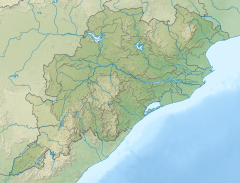| Konark Sun Temple | |
|---|---|
 Main structure of the Sun Temple | |
| Religion | |
| Affiliation | Hinduism |
| District | Puri |
| Deity | Surya (Sun) |
| Festival | Chandrabhaga Melan |
| Governing body | ASI |
| Location | |
| Location | Konark, Puri district, Odisha, India |
| State | Odisha |
| Country | India |
| Geographic coordinates | 19°53′15″N 86°5′41″E / 19.88750°N 86.09472°E |
| Architecture | |
| Style | Kalinga |
| Creator | Narasingha Deva I |
| Completed | c. 1250 |
| Site area | 10.62 ha (26.2 acres) |
| Website | |
| konark | |
| Location | Konark, Odisha, India |
| Criteria | Cultural: (i)(iii)(vi) |
| Reference | 246 |
| Inscription | 1984 (8th Session) |

Konark Sun Temple is a 13th-century CE Hindu Sun temple at Konark about 35 kilometres (22 mi) northeast from Puri city on the coastline in Puri district, Odisha, India.[1][2] The temple is attributed to king Narasingha Deva I of the Eastern Ganga dynasty about 1250 CE.[3][4]
Dedicated to the Hindu Sun-god Surya, what remains of the temple complex has the appearance of a 100-foot (30 m) high chariot with immense wheels and horses, all carved from stone. Once over 200 feet (61 m) high,[1][5] much of the temple is now in ruins, in particular the large shikara tower over the sanctuary; at one time this rose much higher than the mandapa that remains. The structures and elements that have survived are famed for their intricate artwork, iconography, and themes, including erotic kama and mithuna scenes. Also called the Surya Devalaya, it is a classic illustration of the Odisha style of Architecture or Kalinga architecture.[1][6]
The cause of the destruction of the Konark temple is unclear and still remains a source of controversy.[7] Theories range from natural damage to deliberate destruction of the temple in the course of being sacked several times by Muslim armies between the 15th and 17th centuries.[1][7] This temple was called the "Black Pagoda" in European sailor accounts as early as 1676 because it looked like a great tiered tower which appeared black.[6][8] Similarly, the Jagannath Temple in Puri was called the "White Pagoda". Both temples served as important landmarks for sailors in the Bay of Bengal.[9][10] The temple that exists today was partially restored by the conservation efforts of British India-era archaeological teams. Declared a UNESCO World Heritage Site in 1984,[1][2] it remains a major pilgrimage site for Hindus, who gather here every year for the Chandrabhaga Mela around the month of February.[6]
Konark Sun Temple is depicted on the reverse side of the Indian currency note of 10 rupees to signify its importance to Indian cultural heritage.[11]
- ^ a b c d e Konark: India Archived 31 July 2018 at the Wayback Machine, Encyclopædia Britannica
- ^ a b Cite error: The named reference
unescowas invoked but never defined (see the help page). - ^ Sen, Sailendra (2013). A Textbook of Medieval Indian History. Primus Books. pp. 121–122. ISBN 978-9-38060-734-4.
- ^ Indian History. Tata McGraw-Hill Education. 1960. p. 2. ISBN 978-0-07-132923-1. Archived from the original on 1 January 2014. Retrieved 3 May 2013.
- ^ Cite error: The named reference
Harle1994p251was invoked but never defined (see the help page). - ^ a b c Linda Kay Davidson; David Martin Gitlitz (2002). Pilgrimage: From the Ganges to Graceland : an Encyclopedia. ABC-CLIO. pp. 318–319. ISBN 978-1-57607-004-8. Archived from the original on 2 January 2014. Retrieved 30 September 2016.
- ^ a b Thomas Donaldson (2005). Konark. Oxford University Press. pp. 15–28. ISBN 978-0-19-567591-7. Archived from the original on 9 August 2019. Retrieved 9 November 2017.
- ^ Thomas Donaldson (2005). Konark. Oxford University Press. p. 28. ISBN 978-0-19-567591-7. Archived from the original on 9 August 2019. Retrieved 9 November 2017.
- ^ Debala Mitra 1968, p. 3.
- ^ Lewis Sydney Steward O'Malley (2007). Bengal District Gazetteer : Puri. Concept Publishing Company. p. 283. ISBN 978-81-7268-138-8. Archived from the original on 1 January 2014. Retrieved 3 May 2013.
- ^ "RBI to issue new Rs 10 notes with Konark Sun Temple motif". Archived from the original on 30 July 2021. Retrieved 12 December 2020.

